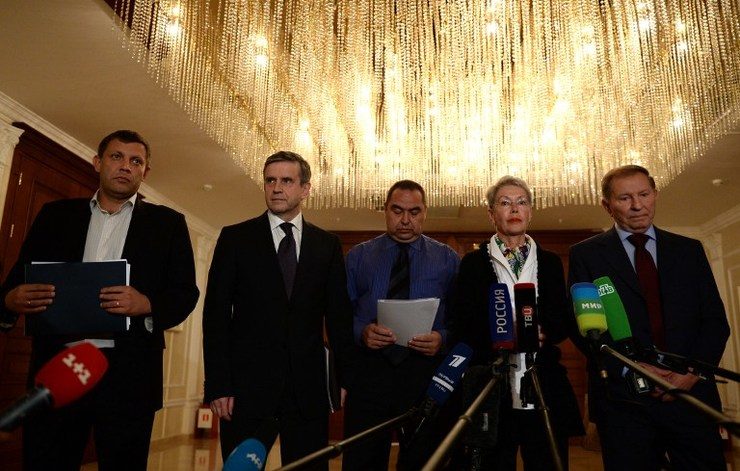SUMMARY
This is AI generated summarization, which may have errors. For context, always refer to the full article.

MINSK, Belarus – Ukraine and pro-Kremlin rebels signed up to a truce Friday, September 5, that could stem nearly five months of bloodshed but is unlikely to quell the separatist drive in the east.
Skeptical Western governments said they still planned to impose tough new sanctions on Moscow over what they claim is Russian aggression in the former Soviet state.
But US President Barack Obama said they could be lifted if the ceasefire holds.
The guns appeared to have fallen silent in eastern Ukraine after both sides ordered a halt to fire at 1500 GMT, despite fierce fighting around the strategic port city of Mariupol in the tense hours before the deal.
The Kremlin-drafted truce has been greeted with skepticism by Western leaders who suspect Russian President Vladimir Putin of trying to cement territorial gains in Ukraine that began with his March seizure of the Black Sea peninsula of Crimea.
The agreement could hand the rebels effective control of Ukraine’s industrial heartland and leave President Petro Poroshenko exposed to charges of signing off on Kiev’s surrender to Putin.
The ceasefire plan was drawn up after a surge in tensions following NATO’s accusations that Russia had sent in heavily-armed troops to support a lightning rebel counter-offensive across the southeast that forced a dramatic reversal of fortunes for the Ukrainian army.
Ukrainian Prime Minister Arseniy Yatsenyuk told his cabinet that the deal required US and EU backing because Kiev could “not manage with Russia on our own”.
“The peace plan must include a ceasefire, the withdrawal of the Russian army, bandits and terrorists, and the re-establishment of the border,” he added.
NATO also approved a new “spearhead” force of several thousand soldiers on Friday and vowed to maintain a “continuous” presence in eastern Europe that could calm the nerves of ex-Soviet satellites that view Putin’s intensions with dread.
Outgoing NATO chief Anders Fogh Rasmussen said the next “crucial step is to implement it (the deal) in good faith”.
“But so far, so good,” he added. “(This) could be the start of a constructive political process.”
The US Department of Defense had warned Thursday, September 4, that the 20,000 Russian troops it suspects are massed on the Ukrainian border were “more lethal” than ever before.
But the Kremlin accuses NATO and Washington of concocting evidence about what some have labelled an invasion by stealth in order to expand its own presence along Russia’s western frontier.
Putin’s spokesman told Russian news agencies he expected the ceasefire to be “thoroughly implemented” and that all sides would continue talks to reach a “full settlement of the Ukraine crisis”.
East’s status uncertain
Poroshenko said he was “satisfied” with the deal, which could see detained fighters on both sides freed on Saturday, September 6.
Yet the pact has done little to calm the separatist passions of insurgents who first overran government buildings across the Russified east in April, deeply mistrustful of the nationalist-leaning government that took power in February after the ouster of a Kremlin-backed leader.
The subsequent fighting has killed around 2,600 people and send at least half a million fleeing their homes.
“(The) ceasefire does not mean a change in our goal to split from Ukraine,” rebel representative Igor Plotnitsky told reporters in Minsk.
The peace plan – first detailed by Putin after telephone talks with Poroshenko earlier this week – could leave the rebels in effective control of a region that accounts for one-sixth of Ukraine’s population and a quarter of its exports.
The Kremlin account of the blueprint said it requires Ukrainian armed forces units to withdraw from positions around the insurgent strongholds of Donetsk and Lugansk.
But it also establishes a “safe zone” that one rebel negotiator said should enable the militias to hold on to territory between Russia and those key cities.
There are also doubts about whether the loose band of rebel field commanders will listen to political leaders such as the self-declared “prime ministers” of Lugansk and Donetsk who approved the pact.
A unilateral truce Poroshenko declared in June was initially backed by the rebels’ political leadership and endorsed by Moscow. But it collapsed 10 days later because of unceasing militia attacks.
And Mariupol resident Viktor Kosobokov, 72, bluntly told Agence France-Presse as he swept the streets that he was opposed to a deal with Kiev.
“We cannot talk to this government which has destroyed half of the Donbass,” he said, referring to the eastern region.
“We must advance onwards to Kiev so they live through what we have had to endure.”
Western troops and sanctions
The deal entered force as EU leaders gathered in Brussels to consider imposing a tough new round of sanctions on Russia by expanding its hit-list of state firms.
Russia responded to earlier measures by banning most Western food imports – an embargo that will cost economically-fragile European nations billions of euros (dollars) a year.
NATO still managed to outrage the Kremlin by approving a new rapid response force for eastern Europe that Moscow has branded a grave national security threat.
“This decision sends a clear message – NATO protects all allies at all times,” said Rasmussen. – With Dmitry Zaks in Kiev, Ukraine, Agence France-Presse/Rappler.com
Add a comment
How does this make you feel?
There are no comments yet. Add your comment to start the conversation.